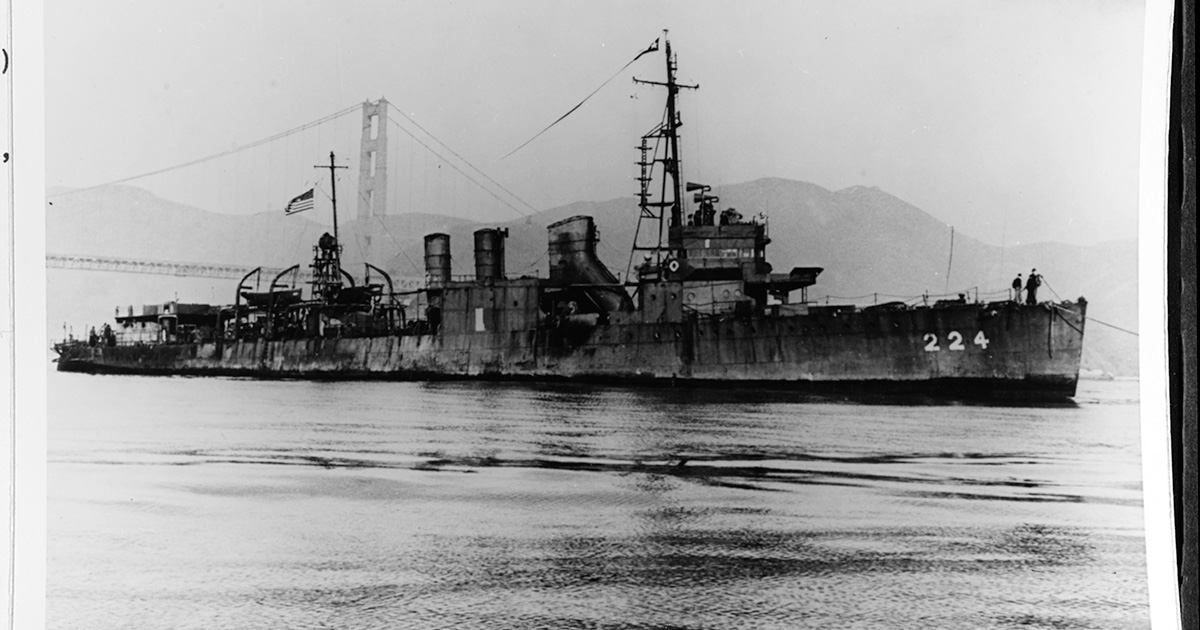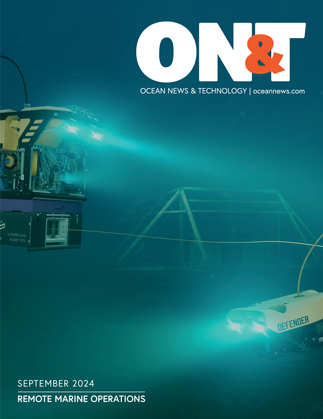The wreck of what was once known as “the ghost ship of the Pacific” was found within the boundaries of the Cordell Bank National Marine Sanctuary and in an area consistent with historical accounts of its final disposal. The Stewart was deliberately sunk on May 24, 1946, as part of a naval exercise in the post-World War II era, seemingly bringing the story of this historic vessel to its close after a remarkable globe-spanning odyssey.

Laid down in Philadelphia, Pennsylvania, in September 1919 and commissioned in September 1920, the Stewart was completed too late to see action in World War I but found itself on the front lines at the start of World War II. In 1941, the Stewart was stationed in Manilla as part of the US Navy’s Asiatic Fleet, an understrength collection of old, largely obsolete warships tasked with opposing Imperial Japan’s onslaught after its devastating attack on Pearl Harbor. The Stewart was damaged during combat in February 1942, and a freak accident trapped it in a repair drydock on Java, where its crew was forced to abandon it as enemy forces prepared to seize the island. Raised and repaired a year later, the Stewart was pressed into service with the Imperial Japanese Navy as Patrol Boat No. 102. Soon, far-ranging Allied pilots began reporting the strange sight of an old American destroyer operating deep behind enemy lines. It was not until the Stewart was found afloat in Kure, Japan, at the end of the war, that the mystery of the Pacific ghost ship was finally solved. The battered veteran vessel was recommissioned back into the US Navy in what was called an “emotional ceremony” and towed home to San Francisco. There, something like a “burial at sea” was performed: the Stewart served its country one last time as a target ship, absorbing fire from aerial rockets, machine guns, and naval guns for more than two hours before sinking. In the following decades, Stewart’s story drew the interest of historians, archaeologists, and naval enthusiasts, and the rediscovery of its wreck became a top national priority for exploration. More than 78 years would pass before it was found.
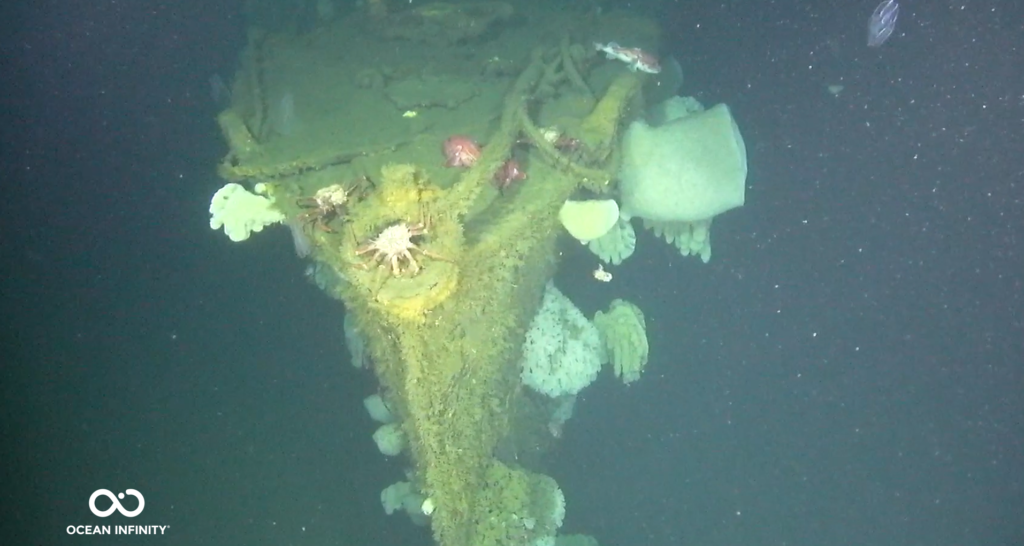
On August 1, 2024, three HUGIN 6000 autonomous underwater vehicles (AUVs) were deployed by Ocean Infinity, one of the world’s leading robotic marine survey companies, to search for the wreck of the Stewart. These state-of-the-art unmanned submersibles, each equipped with high-resolution synthetic aperture sonar (HiSAS) and multibeam echosounder systems, were programmed to simultaneously conduct an extensive and methodical scan of the seafloor that lasted 24 hours. This approach facilitated rapid coverage of a large search area. When the data were retrieved, it revealed the stunning and unmistakable image of a sunken ship 3,500 feet below the surface.
The mission to find the Stewart had begun months earlier when Andy Sherrell, Director of Maritime Operations at Ocean Infinity America, identified an opportunity to test and develop some of the company’s sophisticated technology. He consulted with Russ Matthews, President of the non-profit Air/Sea Heritage Foundation, and with former NOAA Director of Maritime Heritage Dr. James Delgado, now Senior Vice President of SEARCH, one of the nation’s largest cultural resources companies. Matthews and Delgado, with a host of valued colleagues, have worked for years to pinpoint significant sunken vessels and aircraft, connecting with expert partners and seeking collaborative opportunities to illuminate significant but oft-forgotten relics in the ocean’s depths.
For example, a previous (2020) joint endeavor led to the discovery of the wreck of the storied battleship USS Nevada (BB-36)—a veteran of the Pearl Harbor attack, D-Day landings, and Bikini Atoll atomic bomb tests that now rests in the deep sea off Hawaii. Sherrell, Mathews, and Delgado eagerly discussed using the impending San Francisco-area testing and calibration program to search for another important target of great public interest. USS Stewart seemed the obvious choice and a research application was submitted to authorities at NOAA’s Cordell Bank National Marine Sanctuary, who, with the US Navy’s concurrence, issued a permit to conduct a non-disturbance survey for the wreck to Delgado, Matthews, and the team on board the vessel. Matthews also
provided a critical source of evidence in the form of previously classified logbook entries from the US Navy ships involved in sinking the ex-USS Stewart in 1946, which he had retrieved from the National Archives and Records Administration.
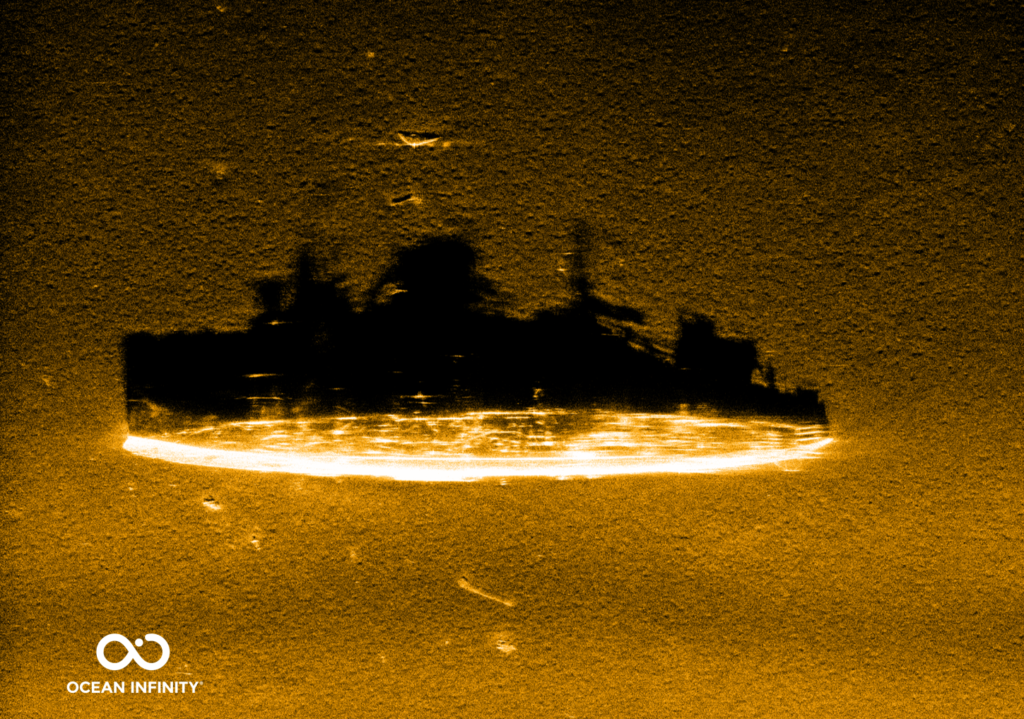
Preliminary sonar scans revealed that the Stewart is largely intact and that its hull—which remains sleek and imposing—rests nearly upright on the seafloor. This level of preservation is exceptional for a vessel of its age and makes it potentially one of the best-preserved examples of a US Navy “four- stacker” destroyer known to exist. The wreck’s condition offers invaluable insights into early twentieth-century naval architecture and technology. Following the initial discovery, the team conducted an additional high-resolution sonar survey and then launched a detailed visual inspection of the site using a camera-equipped remotely operated vehicle (ROV). The video feed was transmitted live from the sea floor using a virtual satellite link to experts and various stakeholders on shore. This group included Matthews and Delgado, as well as National Marine Sanctuaries Chief Historian Willie Hoffman, SEARCH maritime archaeologist Dr. Michael Brennan, and others, who all worked closely with the highly skilled crew as they explored the deep-sea wreck in real time. Also participating in the dive was Rear-Admiral Samuel Perez Jr., USN (Ret), the Executive Chairman of Ocean Infinity America. Admiral Perez’s insights as a former naval-surface warfare officer were invaluable in assessing the wreck and the damage caused by the bombardment that sank it.
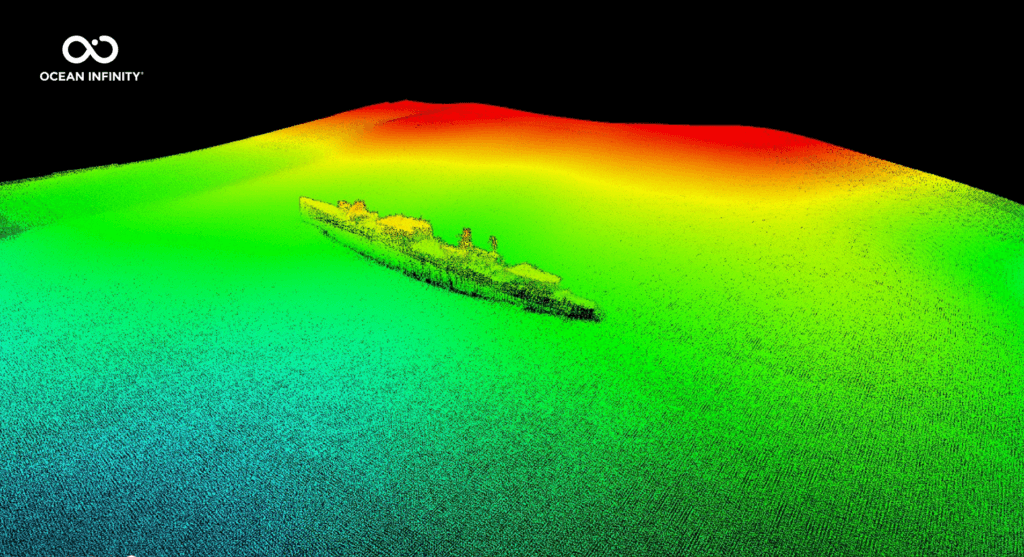
Additionally, the data collected by Ocean Infinity during the survey will be provided to NOAA’s Cordell Bank National Marine Sanctuary to support future environmental assessments. The high-resolution sonar, oceanographic data, and video imagery will offer vital information for habitat characterization, helping NOAA’s scientists monitor and assess marine life in this sensitive area, as well as its ongoing ecological changes. Data associated with the wreck of the Stewart will also be provided to the Naval History and Heritage Command to support future site management.
While watching the evocative video from the seafloor, Matthews recalled reading in the historical record about a touching tribute from the sailors who brought the Stewart home. The sailors took to calling their charge “RAMP-224,” which is a combination of the vessel’s navy hull number and a period slang term for returning prisoners of war or Recovered Allied Military Personnel. “It’s clear they thought of Stewart more like a shipmate than a ship,” Matthews said, “and I know I speak for the entire expedition team when I say that we’re all very satisfied to have helped honor the legacy and memory of those veterans once again.” Dr. Delgado added, “The USS Stewart represents a unique opportunity to study a well-preserved example of early twentieth-century destroyer design. Its story, from US Navy service to Japanese capture and back again, makes it a powerful symbol of the Pacific War’s complexity.”
Rear Admiral Samuel J. Cox USN (Ret), the Director of Naval History and Heritage Command and Curator for the US Navy, also weighed in, saying, “The US Navy greatly appreciates the professionalism of the team that located the wreck of the USS Stewart. Whether lost in battle or sunk as a target, a warship remains sovereign property in perpetuity. It is important to know the location and condition of such wrecks so that they may be protected from unauthorized disturbance under the US Sunken Military Craft Act.
